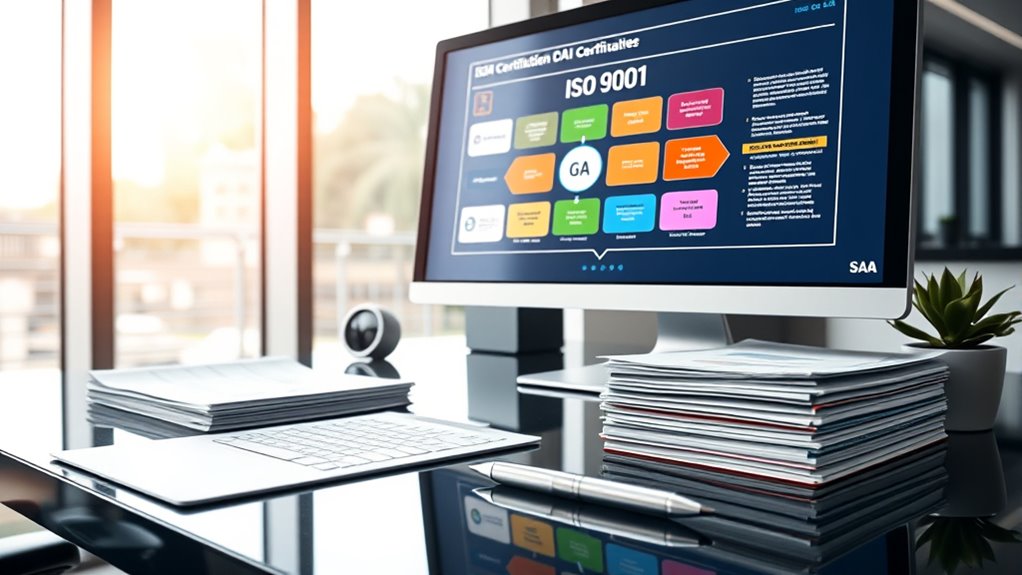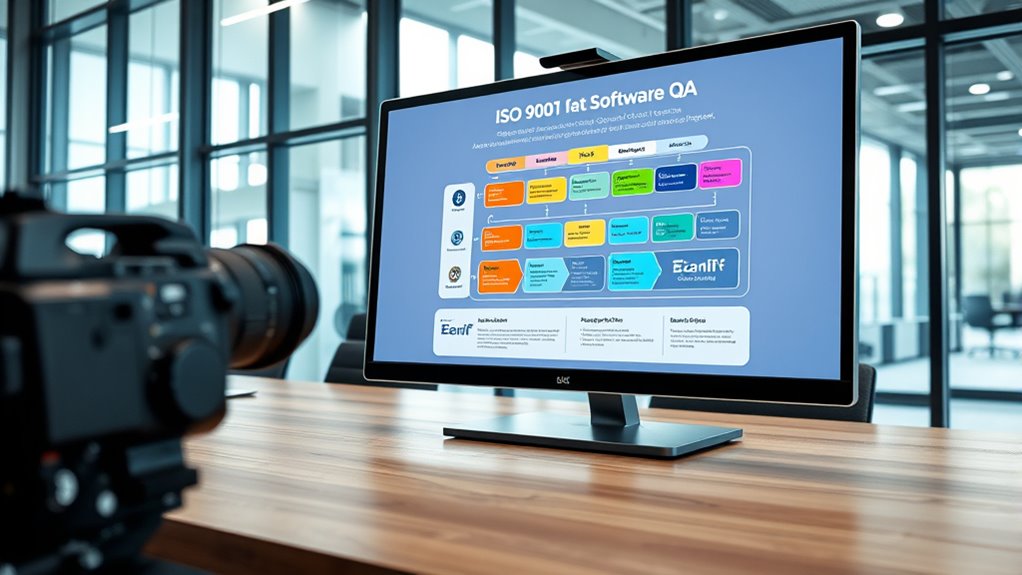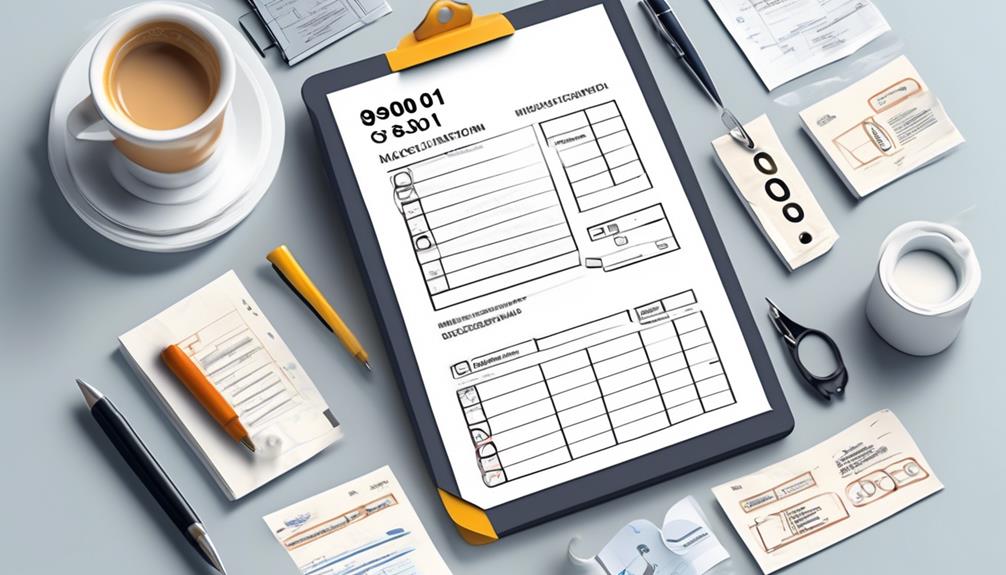To achieve ISO 9001 certification for software QA, you should start by understanding the standard’s requirements and establishing a strong quality management system. Focus on risk management, documenting your processes, and maintaining that documentation through regular updates. Incorporate continuous improvement practices, embed risk mitigation strategies, and foster transparency. If you continue exploring, you’ll uncover detailed steps to smoothly guide your organization toward certification and long-term quality success.
Key Takeaways
- Understand ISO 9001 requirements and align your software QA processes accordingly.
- Conduct risk assessments early to identify potential quality and compliance gaps.
- Develop comprehensive documentation including quality plans, procedures, and audit records.
- Implement continuous improvement practices through regular reviews and updates of documentation and processes.
- Prepare for certification audits by demonstrating effective risk management and consistent documentation practices.

Achieving ISO 9001 certification for your software quality assurance (QA) processes demonstrates a commitment to consistently delivering high-quality products and meeting customer expectations. This certification helps you establish a systematic approach to managing quality, which is crucial in today’s competitive software industry. One of the key aspects of this process involves implementing effective risk management strategies. You need to identify potential risks early in your development lifecycle, analyze their possible impacts, and develop mitigation plans. This proactive approach not only minimizes defects and delays but also enhances your ability to respond swiftly to issues before they escalate. Risk management becomes embedded into your daily operations, ensuring that quality is maintained even when unforeseen challenges arise.
In addition to managing risks, adhering to documentation standards is critical for achieving and maintaining ISO 9001 certification. Proper documentation provides a clear record of your processes, decisions, and improvements, enabling consistent application across your organization. You should develop extensive documentation standards that specify what information needs to be recorded, how it should be formatted, and where it should be stored. This includes detailed process descriptions, quality plans, testing procedures, and audit records. Well-maintained documentation not only supports compliance but also facilitates continuous improvement. When everyone follows the same documentation standards, you reduce ambiguities, improve transparency, and make it easier to trace problems back to their root causes.
Implementing these standards requires you to establish clear procedures for updating and reviewing documentation regularly. This ensures that your quality management system remains aligned with industry best practices and evolving customer requirements. Moreover, documentation acts as evidence during audits, demonstrating your commitment to quality standards. It’s important that you train your team to understand the importance of accurate records, as this fosters accountability and consistency in your QA efforts. Additionally, incorporating a focus on physical materials such as wood, stone, and linen can enhance the authenticity of your documentation environment, much like natural elements reinforce the farmhouse aesthetic.
Throughout this process, you’ll find that integrating risk management and documentation standards into your ISO 9001 compliance efforts creates a solid foundation for continuous improvement. These elements support a culture of quality where every team member is aware of their role in maintaining high standards. They also enable you to identify gaps, streamline workflows, and enhance overall product reliability. As you progress toward certification, remember that these practices are not just bureaucratic requirements—they’re essential tools to help you deliver better software, satisfy your customers, and stay competitive in a rapidly changing industry. By focusing on risk management and documentation standards, you set yourself up for long-term success and a robust quality management system.
Frequently Asked Questions
How Long Does the Certification Process Typically Take?
The certification process usually takes around three to six months, depending on your company’s readiness. You need to guarantee your documentation requirements are complete and aligned with ISO standards. During this time, auditors with proper qualifications review your processes, so be prepared for inspections. If you address gaps promptly and maintain thorough documentation, you can streamline the process and achieve certification faster.
What Are the Costs Involved in Obtaining ISO 9001?
Think of obtaining ISO 9001 like building a house—you need a solid foundation, which requires a clear cost analysis. Costs vary based on company size, complexity, and consulting fees. Budget planning should include training, documentation, and audit expenses. Generally, smaller firms spend a few thousand dollars, while larger organizations might invest tens of thousands. Being thorough helps avoid surprises and guarantees you allocate enough resources for successful certification.
Can Small Software Companies Achieve ISO 9001 Certification?
Yes, small software companies can achieve ISO 9001 certification. It strengthens your Quality Assurance processes and demonstrates your commitment to quality, which appeals to clients. While the process might seem challenging, with proper planning, you’ll see Certification Benefits like improved efficiency and customer satisfaction. Focus on your unique needs, leverage affordable resources, and stay dedicated to the standards, making certification both attainable and valuable for your business growth.
How Often Must Organizations Undergo Audits for Compliance?
You can’t manage what you don’t measure, so stay on top of your compliance schedule. Audits for ISO 9001 certification typically happen annually, but the exact audit frequency depends on your organization’s size and complexity. Regular audits help ensure ongoing compliance, identify areas for improvement, and maintain certification. Keep your audit schedule consistent, and you’ll stay aligned with standards and avoid surprises.
What Are Common Challenges Faced During Certification?
You might face challenges like maintaining exhaustive quality documentation and ensuring consistent employee training. Keeping records up-to-date can be time-consuming, and staff turnover may disrupt ongoing training efforts. Additionally, aligning your processes with ISO standards requires continuous effort. To overcome these hurdles, focus on creating clear documentation and implementing robust training programs, which help streamline compliance and reduce errors during the certification process.
Conclusion
Achieving ISO 9001 certification for your software QA is like planting a sturdy tree—your efforts will grow into a strong foundation of quality and trust. By following this step-by-step guide, you’re not just ticking boxes; you’re building a reliable system that boosts customer confidence and streamlines your processes. Stay committed, keep your eyes on the goal, and watch your quality standards flourish like a well-tended garden. Your dedication will turn certification into your greatest asset.









